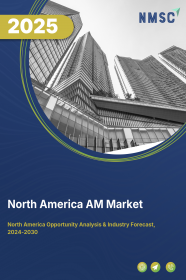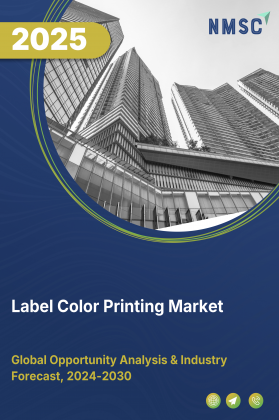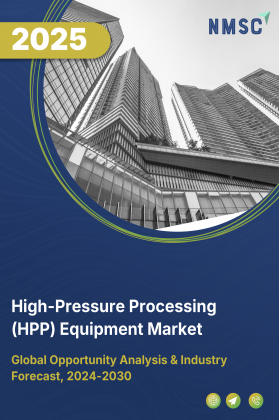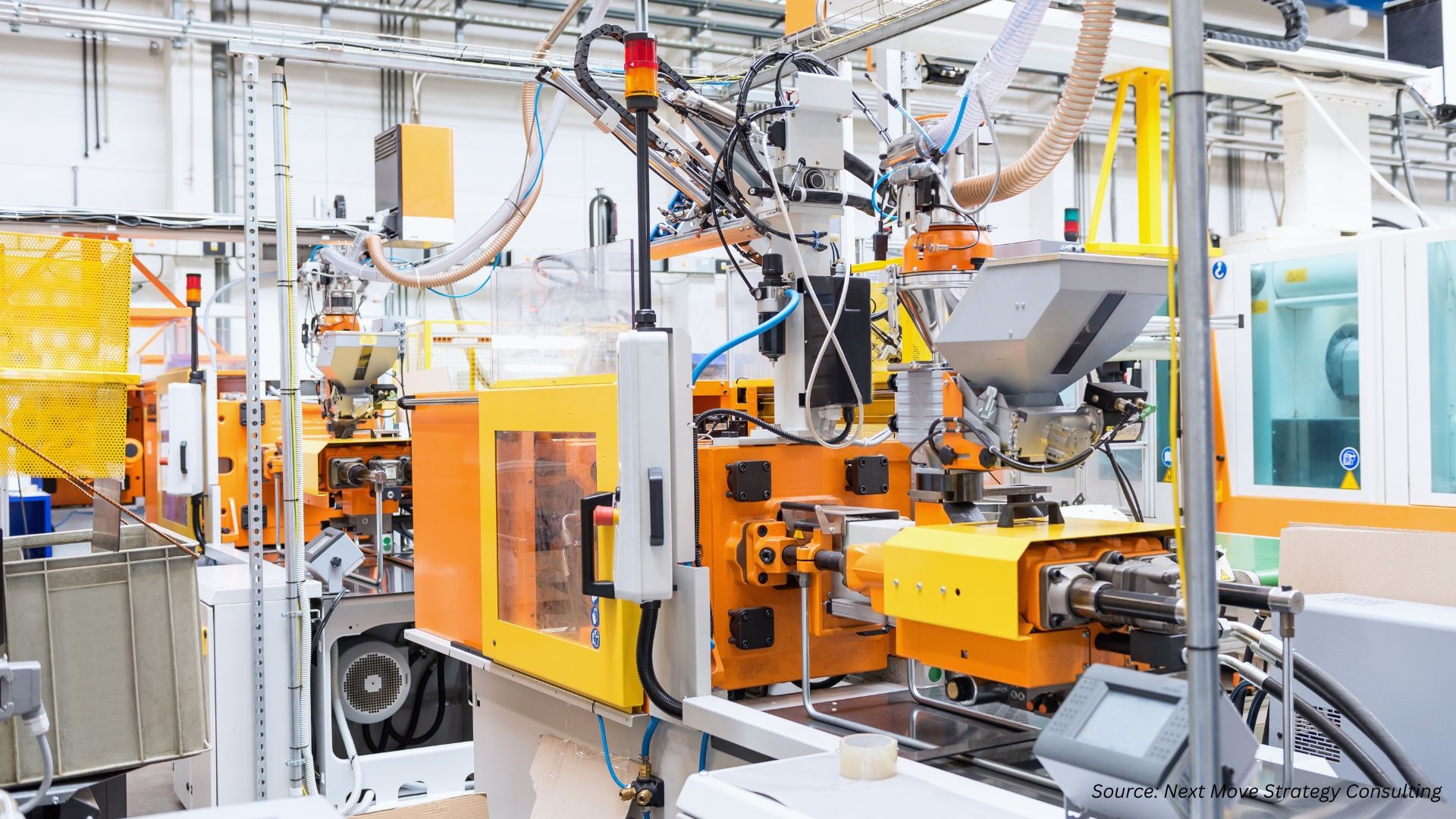
North America Additive Manufacturing Market by Offering (Printers, Materials, Software, and Services), by Technology (Fused Deposition Modelling (FDM), Stereolithography (SLA), and Other Technologies), by Process (Powder Bed Fusion (PBF), Vat Photopolymerization, and Other Processes), by Application (Prototyping, Tooling, and Functional Part Manufacturing), by Vertical (Automotive, Aerospace & Defense, Healthcare, and Other Verticals) – Opportunity Analysis and Industry Forecast, 2024–2030.
Industry: Construction & Manufacturing | Publish Date: 22-Aug-2025 | No of Pages: 160 | No. of Tables: 153 | No. of Figures: 98 | Format: PDF | Report Code : CM645
North America Additive Manufacturing Market Overview
The North America Additive Manufacturing Market size was valued at USD 7.46 billion in 2023, and is predicted to reach USD 30.32 billion by 2030, at a CAGR of 20.7% from 2024 to 2030. In terms of volume, the market size was 355 thousand units in 2023, and is projected to reach 1677 thousand units by 2030, with a CAGR of 22.7% from 2024 to 2030.
The additive manufacturing (AM) market, also known as additive layer manufacturing (ALM) or three-dimensional (3D) printing, encompasses the global industry focused on the development, production, and distribution of technologies and materials used to create three-dimensional objects layer by layer from digital models. This market serves various sectors, including aerospace, automotive, healthcare, and consumer goods, providing innovative solutions for prototyping, production, and custom manufacturing.
AM is known for its ability to produce highly complex and customized components with minimal material waste, resulting in significant cost savings and environmental benefits. A key characteristic of this market is the variety of printing technologies available, such as stereolithography (SLA), selective laser sintering (SLS), and fused deposition modelling (FDM), each designed for specific industry needs and applications. Additionally, the rapid prototyping capability of AM accelerates product development cycles, enabling businesses to innovate and bring products to market more quickly than traditional manufacturing methods.
Accelerated Automotive Transition to Lightweight & Electric Mobility
North America’s automotive sector is rapidly embedding AM into production, driven by the imperative to reduce vehicle weight and support scalable EV manufacturing. Leading OEMs and Tier‑1 suppliers are using binder‑jet metal printing and laser powder bed fusion to produce complex components—like battery enclosures, thermal management structures, and load-bearing brackets—that balance precision, customization, and performance. This shift is not only reshaping supply chains but also enhancing vehicle efficiency and range, as manufacturers look to optimize every gram in the push toward sustainable, next-generation mobility.
Explosive Growth in Healthcare-Driven Precision & Tailored Treatments
North America’s healthcare ecosystem is witnessing surging demand for tailored medical solutions powered by AM. Hospitals, clinics, and device makers are scaling patient-specific implants, surgical guides, and anatomical models—significantly improving surgical precision and care outcomes. The rise of point-of-care printing within hospital environments is reducing time-to-treatment and supply-chain complexity. Innovations in bioprinting, surgical modeling, and custom prosthetics are being financed heavily by both public institutions and private investment—a transformation that’s proving both clinically impactful and commercially scalable.
Skilled Workforce Shortages Hinder AM Scale-Up
North America’s additive manufacturing market is significantly constrained by a deficit of trained operators, engineers, and technicians—professionals with the specialized skills to run, optimize, and integrate AM systems into conventional production lines. Despite growing demand propelled by nearshoring and AM-centric expansion, factory floors across the U.S. and Canada are struggling to fill highly skilled roles, including equipment programming, materials handling, and post-processing expertise.
This shortage has multiple consequences: delays in machine deployment, increased reliance on expensive upskilling programs or external service bureaus, and slower ROI, especially for small and mid-sized manufacturers. The talent gap is exacerbated by demographic trends—retiring Baby Boomers and lukewarm youth enrollment in vocational paths—creating a persistent staffing scarcity in advanced manufacturing.
Efforts like apprenticeship programs, federal workforce alliances, and vocational-reskilling initiatives are underway—but progress is gradual, and scaling AM operations remains difficult. Until North America builds a stronger, more sustainable AM talent pipeline, workforce bottlenecks will continue to temper market expansion.
Autonomous Post-Processing and Robotic Finishing Streamline am Production
North America’s additive manufacturing market is set to advance through the adoption of autonomous post-processing and robotic finishing systems. These technologies automate tasks like support removal, surface smoothing, and dimensional inspection—areas that traditionally slow down production and require skilled labor.
By integrating machine vision and adaptive robotics, manufacturers can achieve consistent quality, reduced lead times, and higher throughput, especially in metal AM. With strong regional capabilities in automation and smart manufacturing, North America is well-positioned to scale these solutions—enhancing efficiency, reducing costs, and enabling broader industrial adoption.
The U.S. Holds the Dominant Market Share in North America Additive Manufacturing Market
The increase in spending by the automotive industry in the U.S. is boosting the North America additive manufacturing market demand for AM technologies, as automakers allocate resources towards innovative solutions that enhance efficiency, cost-effectiveness, and agility in production processes. By investing in additive manufacturing, automotive companies aim to optimize manufacturing workflows, reduce lead times, and introduce novel designs that cater to evolving consumer preferences and regulatory standards. According to a report published by the Center for Automotive Research in 2022, the U.S. automotive industry spends approximately USD 16 to USD 18 billion annually on research and product development, with 99% of that funded by the industry itself. This surge in spending reflects a strategic shift towards the adoption of AM for rapid prototyping, tooling, and the production of end-use parts within the country’s automotive sector.
Furthermore, growing investment in healthcare in the U.S. is driving the demand for AM as the industry seeks innovative solutions to meet the needs of personalized medicine, patient-specific treatments, and medical device customization. With rising healthcare expenditures, there is a pressing need for cost-effective, on-demand production of complex medical components, prosthetics, implants, and surgical guides, all of that are efficiently achieved through AM technologies. According to the American Medical Association report in 2024, healthcare spending in the U.S. increased by 4.1% to approximately USD 4.4 trillion in 2022. This surge in healthcare investment necessitates the adoption of advanced medical devices such as AM for revolutionizing patient care, improving treatment outcomes, and advancing the overall quality and accessibility of healthcare services in the U.S.
Mexico to Witness Substantial Growth in the North America Additive Manufacturing Market
The growth of the consumer goods industry in Mexico is driving the demand for AM as companies strive to meet evolving consumer preferences for customized, high-quality products while maintaining cost-efficiency. AM allows manufacturers to produce personalized goods on-demand, reducing inventory costs and enabling rapid design iterations to keep pace with changing consumer trends. From customizable electronics to unique home goods and fashion accessories, additive manufacturing provides flexibility and agility in production, enabling Mexican consumer goods companies to differentiate themselves in the market and cater to niche customer segments. According to the ITA 2023, the retail industry in Mexico generated around USD 76 billion, encompassing over 47,000 retail stores. As the consumer goods industry continues to expand in the country, the adoption of AM technologies accelerates, further fueling innovation and market competitiveness in the sector.
Additionally, the significant growth of the healthcare sector in Mexico is driving the adoption of AM technologies as healthcare providers seek innovative solutions to address patient-specific needs, improve medical device customization, and enhance overall patient care. Additive manufacturing enables the production of personalized implants, prosthetics, and surgical tools tailored to individual patients. It also facilitates the rapid prototyping and iteration of medical devices, accelerating the development timeline and fostering the translation of medical innovations into practical healthcare solutions.
According to the latest report published by ITA, in 2022, Mexico's domestic manufacturing of medical devices reached approximately USD 16.33 billion, while its export value amounted to around USD 6.92 billion. The expansion of the healthcare sector in the country highlights the increasing demand for AM technologies to meet the evolving needs of patients and healthcare providers.
Competitive Landscape
The prominent key players operating in the North America additive manufacturing industry include Stratasys Ltd., 3D Systems Corporation, Desktop Metal, Inc., Materialise NV, EOS GmbH, Formlabs, Inc., HP Inc., Carbon Inc., Protolabs, Markforged Inc., SLM Solutions, Velo3D, Renishaw Plc, GE Additive, Forge Nano, and others.
North America Additive Manufacturing Market Key Segments
By Offering
-
Printers
-
Desktop Printers
-
Industrial Printers
-
-
Materials
-
Plastics
-
Thermoplastics
-
Photopolymers
-
-
Metals
-
Steel
-
Aluminum
-
Titanium
-
Nickel
-
Other metals
-
-
Ceramics
-
Other Materials
-
Wax
-
Laywood
-
Paper
-
Biocompatible materials
-
-
-
Software
-
Design
-
Inspection
-
Printing
-
Scanning
-
- Services
By Technology
-
Fused Deposition Modelling (FDM)
-
Stereolithography (SLA)
-
Selective Laser Sintering (SLS)
-
Polyjet Printing/Multijet Printing (MJP)
-
Electron Beam Melting (EBM)
-
Digital Light Processing (DLP)
-
Direct Metal Laser Sintering (DMLS)
-
Other Technologies
By Process
-
Powder Bed Fusion (PBF)
-
Vat Photopolymerization
-
Binder Jetting
-
Material Extrusion
-
Material Jetting
-
Other Processes
By Application
-
Prototyping
-
Tooling
-
Functional Part Manufacturing
By Vertical
-
Automotive
-
Aerospace & Defense
-
Healthcare
-
Architecture & Construction
-
Education
-
Industrial
-
Energy
-
Printed Electronics
-
Jewelry
-
Food & Culinary
-
Other Verticals
By Region
-
North America
-
The U.S.
-
Canada
-
Mexico
-
Key Players
-
Stratasys Ltd.
-
3D Systems Corporation
-
Desktop Metal, Inc.
-
Materialise NV
-
EOS GmbH
-
Formlabs, Inc.
-
HP Inc.
-
Carbon Inc.
-
Protolabs
-
Markforged Inc.
-
SLM Solutions
-
Velo3D
-
Renishaw Plc
-
GE Additive
-
Forge Nan
REPORT SCOPE AND SEGMENTATION:
|
Parameters |
Details |
|
Market Size Value in 2023 |
USD 7.46 billion |
|
Revenue Forecast in 2030 |
USD 30.32 billion |
|
Growth Rate |
CAGR 20.7% from 2024 to 2030 |
|
Market Volume in 2023 |
355 thousand units |
|
Market Forecast in 2030 |
1677 thousand units |
|
Volume Growth Rate |
CAGR of 22.7% from 2024 to 2030 |
|
Analysis Period |
2023–2030 |
|
Base Year Considered |
2023 |
|
Forecast Period |
2024–2030 |
|
Market Size Estimation |
Billion (USD) |
|
Growth Factors |
|
|
Companies Profiled |
15 |
|
Market Share |
Available for 10 companies |
|
Countries Covered |
3 |
|
Customization Scope |
Free customization (equivalent up to 80 working hours of analysts) after purchase. Addition or alteration to country, regional, and segment scope. |
|
Pricing and Purchase Options |
Avail customized purchase options to meet your exact research needs. |

















 Speak to Our Analyst
Speak to Our Analyst
























